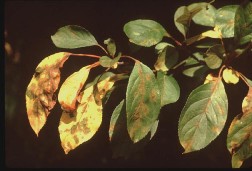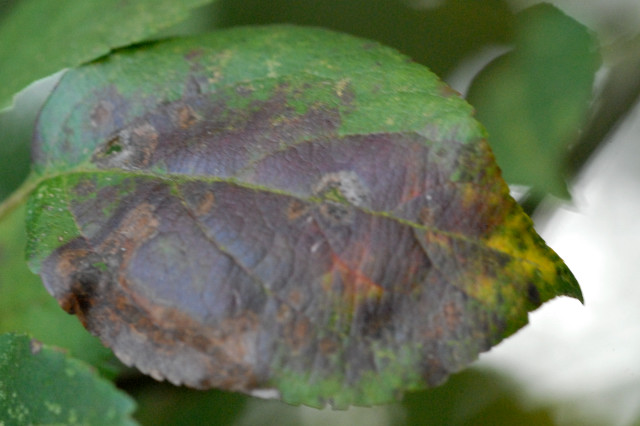Description & Treatment
Apple Scab is a fungal disease which can affect the leaves, fruit, and twigs of flowering, ornamental trees such as crabapple, hawthorn (Venturia inequalis) and pear (V. pirina). Infection on newly emerging leaves is favored by wet and cool spring conditions.
Early symptoms of Apple Scab are brownish-green spots on the leaves or fruit. As the infection progresses, the spots become darker and more prominent and take on a velvety texture due to spore (conidia) formation. Severe infections result in leaf drop off and thinned canopy early, in the summer months.

Apple scab overwinters on fallen leaves.
It is therefore important to rake up and remove infected leaves after leaf fall. The release of spores from fallen leaves usually coincides with bud break and continues through the flowering period. Lesions on leaves and flowers are the source of infective spores that lead to secondary infections. Secondary infections spread rapidly when wet conditions persist for 24 hours with temperatures >50F.

Fungicide treatments should be coordinated with the infective periods.
Foliar applications of PHOSPHO-jet are made at pre bloom (bud swell or silver tip stage) and every 7 days until end of bloom period. Foliar applications of Propizol in crabapple trees may likewise be applied every 21 days from bud swell or silver tip stage. Alternatively, apply Propizol by trunk injection. Make applications when the trees are in full leaf and actively growing for control of the next season’s leaf disease development.
Apple Scab can be treated with: Propizol® Fungicide (Crabapples only) or PHOSPHO-jet.
*Propizol is for ornamental use only. Fruit are not to be used for human or animal consumption.
